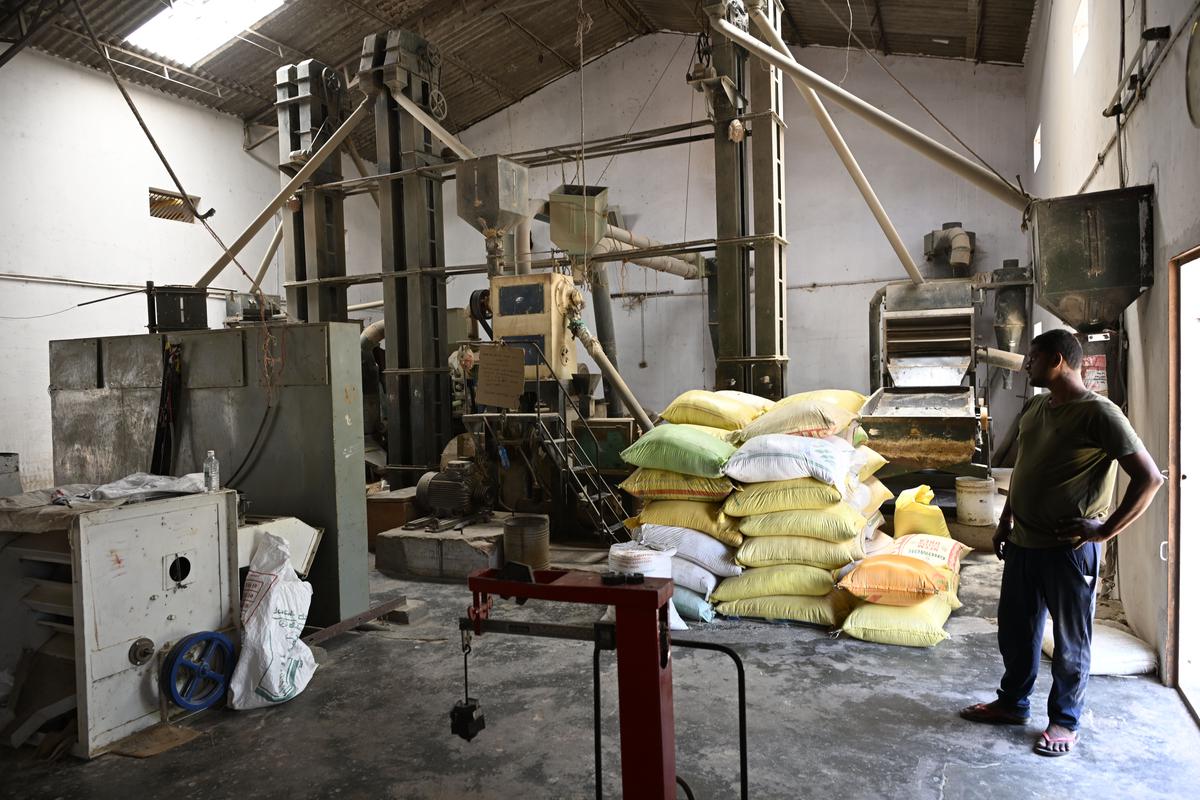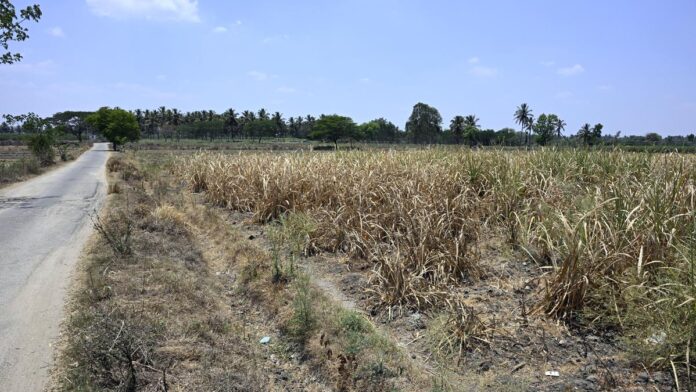Sugarcane crop misplaced as a consequence of drought at Mandya district of Karnataka.
| Picture Credit score: Ok Bhagya Prakash
Round midday, Krishne Gowda sits idle at his Chandrashekara Rice Mill in Keelara in Mandya district of south Karnataka, ready for farmers to get their paddy for hulling. Arrivals are all the way down to a trickle following a decline in crop manufacturing as a consequence of drought.
“Harvesting begins round November-December, and we’d get paddy until about Might. Previously, on a mean, over 30 farmers would come day by day. The quantity has dwindled to 2 or three farmers, because the crop was meagre. Even then, the amount coming in is hardly 40 to 50 kg, a decline from greater than a quintal (100 kg) that every farmer would carry. My mill is barely operational. I’ve decreased my workers from six to 2. To prime all of it, the minimal consumer cost has gone up from ₹2,300 to ₹9,500,” says Mr. Gowda whose mill is positioned in drought-hit Mandya district.

A rice mill lies idle as a consequence of drought in Mandya district of Karnataka. Workers have been laid off owing to lack of enterprise.
| Picture Credit score:
Ok Bhagya Prakash
No scope for late rabi crop
Extremely depending on water from the historic Krishna Raja Sagar (KRS) reservoir throughout river Cauvery, a big a part of the irrigated areas within the district are recognized for paddy and sugarcane. Many farmers didn’t domesticate paddy over the past kharif although authorities launched water after initially asking farmers to not domesticate paddy. The depleting water degree at KRS didn’t present any scope for the late rabi crop.
In a district that’s the fulcrum of Vokkaliga politics, the place water can be an emotional problem and persons are recognized for his or her robust political opinions, the Centre-State spat over the discharge of drought reduction appears to be a problem. The main focus of political narratives within the intensely fought election, during which former Chief Minister H.D. Kumaraswamy is within the fray because the BJP-Janata Dal (Secular) alliance candidate, has been on the ‘ill-effects’ of ensures versus the ‘much-needed sustenance’ it has supplied in a drought 12 months.
Two views on ensures
“The State Authorities has stopped contribution of ₹4,000 in Kissan Samman during which Centre pays ₹6,000. The ₹2,000 given as drought reduction by the State is peanuts. Why ought to the federal government spend a lot on ensures and level in direction of the Centre for drought reduction?” stated Panchalingu in Keregodu. “Farmers are promoting cow dung to make some cash although they require it for his or her land. For a small amount of money, some are even pawning their jewelry with native money-lenders.”
Contradicting him is Lakshmamma, in her 50s, who makes a dwelling as a dairy farmer in Keelara. She argued that the ensures, particularly the Gruha Lakshmi, has helped her run the household on this drought 12 months. Whereas she doesn’t have land, she struggles to handle fodder for her three cows. “I don’t know politics, however all I do know is that the Congress authorities is giving girls cash that’s serving to to run their households. Most ladies within the village are pleased with the ensures.”
Failed borewells
Farmers, who tried to courageous the drought to domesticate sugarcane utilizing groundwater, are additionally in misery because the crops but to mature are wilting since a lot of borewells have run dry, or seen a decline in yield.

Tomato crop wilting beneath the scorchign warmth at Melkote in Mandya district of Karnataka.
| Picture Credit score:
Ok Bhagya Prakash
In a bid to guard his sugarcane, Lohit in Keregodu has sunk two borewells, however each failed. Now, his crop has wilted. “If water was launched in March and April, I may have saved my crop and borewells within the space would have been charged.”
Farmers whose crops are over 9 months outdated try to recuperate part of their funding by promoting their yet-to-mature cane to jaggery items at a cheaper price.
“We’re shopping for 9 to 10-month-old cane at costs starting from ₹1,200 to ₹1,900 per tonne. If one tonne of mature cane yields 1.1 quintals (1 quintal = 100 kg) of jaggery, that is giving us 70 kg, however not of excellent high quality,” stated B.C. Venkatesh of SLV Jaggery unit in Bilidegalu.
Dry land crops higher off
Within the usually dry and partially irrigated Nagamangala, farmers depending on rain-fed crops have managed to maintain.
“These depending on irrigation failed this time. However, we obtained good ragi and horse gram crops,” stated Jayendra Gowda, former president of Honakere Gram Panchayat.
The misery has been made acute as dairy farmers are discovering it laborious to keep up their cows which might be already yielding much less milk as a consequence of excessive warmth. For many years, dairy farming has supplied a sustainable dwelling. Mandya is among the many excessive milk producing districts in Karnataka. Those that managed paddy have inventory of dry grass, however others are compelled to buy at a excessive value.
Fodder in brief provide
Ravi, a resident of Keelara, offered two of his three cows, as fodder availability has come down. “I’m rising inexperienced fodder on my land from a borewell that’s yielding much less water. I couldn’t preserve multiple cow.”
Like thousand of farmers awaiting the discharge of presidency subsidy of ₹5 per litre, Gejjelgere farmer Jayakumar stated, “The federal government may have launched the subsidy on this time of misery. The final cost got here in December 2023. We have no idea when the following cost will come.”
